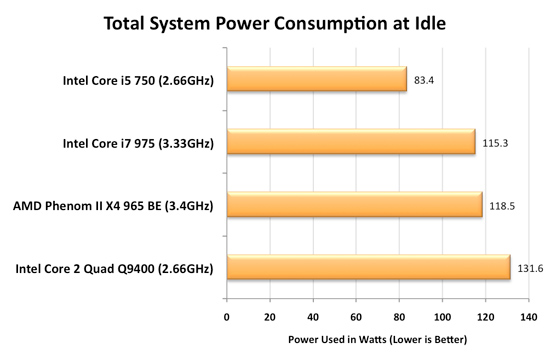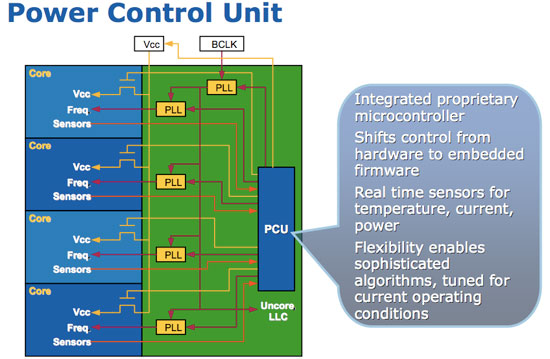Intel's Core i7 870 & i5 750, Lynnfield: Harder, Better, Faster Stronger
by Anand Lal Shimpi on September 8, 2009 12:00 AM EST- Posted in
- CPUs
Homework: How Turbo Mode Works
AMD and Intel both figured out the practical maximum power consumption of a desktop CPU. Intel actually discovered it first, through trial and error, in the Prescott days. At the high end that's around 130W, for the upper mainstream market that's 95W. That's why all high end CPUs ship with 120 - 140W TDPs.
Regardless of whether you have one, two, four, six or eight cores - the entire chip has to fit within that power envelope. A single core 95W chip gets to have a one core eating up all of that power budget. This is where we get very high clock speed single core CPUs from. A 95W dual core processor means that individually the cores have to use less than the single 95W processor, so tradeoffs are made: each core runs at a lower clock speed. A 95W quad core processor requires that each core uses less power than both a single or dual core 95W processor, resulting in more tradeoffs. Each core runs at a lower clock speed than the 95W dual core processor.
The diagram below helps illustrate this:
| Single Core | Dual Core | Quad Core | Hex Core | |
| TDP |  |  |  |  |
| Tradeoff |  |  |  |  |
The TDP is constant, you can't ramp power indefinitely - you eventually run into cooling and thermal density issues. The variables are core count and clock speed (at least today), if you increase one, you have to decrease the other.
Here's the problem: what happens if you're not using all four cores of the 95W quad core processor? You're only consuming a fraction of the 95W TDP because parts of the chip are idle, but your chip ends up being slower than a 95W dual core processor since its clocked lower. The consumer has to thus choose if they should buy a faster dual core or a slower quad core processor.
A smart processor would realize that its cores aren't frequency limited, just TDP limited. Furthermore, if half the chip is idle then the active cores could theoretically run faster.
That smart processor is Lynnfield.
Intel made a very important announcement when Nehalem launched last year. Everyone focused on cache sizes, performance or memory latency, but the most important part of Nehalem was far more subtle: the Power Gate Transistor.
Transistors are supposed to act as light switches - allowing current to flow when they're on, and stopping the flow when they're off. One side effect of constantly reducing transistor feature size and increasing performance is that current continues to flow even when the transistor is switched off. It's called leakage current, and when you've got a few hundred million transistors that are supposed to be off but are still using current, power efficiency suffers. You can reduce leakage current, but you also impact performance when doing so; the processes with the lowest leakage, can't scale as high in clock speed.
Using some clever materials engineering Intel developed a very low resistance, low leakage, transistor that can effectively drop any circuits behind it to near-zero power consumption; a true off switch. This is the Power Gate Transistor.

On a quad-core Phenom II, if two cores are idle, blocks of transistors are placed in the off-state but they still consume power thanks to leakage current. On any Nehalem processor, if two cores are idle, the Power Gate transistors that feed the cores their supply current are turned off and thus the two cores are almost completely turned off - with extremely low leakage current. This is why nothing can touch Nehalem's idle power:

Since Nehalem can effectively turn off idle cores, it can free up some of that precious TDP we were talking about above. The next step then makes perfect sense. After turning off idle cores, let's boost the speed of active cores until we hit our TDP limit.

On every single Nehalem (Lynnfield included) lies around 1 million transistors (about the complexity of a 486) whose sole task is managing power. It turns cores off, underclocks them and is generally charged with the task of making sure that power usage is kept to a minimum. Lynnfield's PCU (Power Control Unit) is largely the same as what was in Bloomfield. The architecture remains the same, although it has a higher sampling rate for monitoring the state of all of the cores and demands on them.
The PCU is responsible for turbo mode.










343 Comments
View All Comments
JonnyDough - Thursday, September 10, 2009 - link
Were you purposely reiterating my point? :DI don't think AMD ever much cared about what Intel was doing. In business class I was taught to keep an eye on a competitor but to really focus on what you are doing. I think AMD was planning their next move, and it had little to do with what Intel was doing or planned on doing, but rather the reaction of what Intel would do when they created Athlon and the next step to being a successful innovative company. Going graphics was just a logical step, since NVidia had no real competition in this space. They saw a market that was ruled by two giants, and decided to combine technology. I'm not so sure that Intel had the idea first. Don't forget, there are leaks in this industry, and people are getting paid to snitch.
tajmahal - Tuesday, September 8, 2009 - link
This is the first time i've ever seen an article written using wholesale x 1,000 prices. Is there any reason you didn't take the trouble to post actual retail pricing?JonnyDough - Tuesday, September 8, 2009 - link
He probably wrote this article prior to today and based it off Intel's pricing scheme...I would think you'd probably gather that. NewEgg is also not the only E-tailer/Retailer out there...ViRGE - Tuesday, September 8, 2009 - link
The last time I checked, those are the only prices Intel gives out. The actual retail prices are a combination of what the retailer paid (buy more, spend less) and whatever markup they add. Intel doesn't have an MSRP.tajmahal - Tuesday, September 8, 2009 - link
i5 750 = $210i7 860 = $300
i7 870 = $580
Just in case someone wants to buy just 1 instead of 1,000. Newegg prices
Gary Key - Tuesday, September 8, 2009 - link
"i5 750 = $210i7 860 = $300
i7 870 = $580
Just in case someone wants to buy just 1 instead of 1,000. Newegg prices "
Retail prices fluctuate greatly at launch. This is what I paid for our retail processors with tax mind you. ;)
i5 750 = $205
i7 860 = $306
i7 870 = $564
cycleback - Tuesday, September 8, 2009 - link
Could you post some Linpack and finite element code benchmarks. This would approximate a larger number of HPC workloads. I would really appreciate this as it is difficult to find these sorts of benchmarks. It would also really test the difference in memory bandwidth between Bloomfield and Lynfield.tacoburrito - Tuesday, September 8, 2009 - link
From the benchmarks, the i7 920 and the i5 seems to be even; each winning about half the benchmarks. If costs for both are the same (proc and mobo), I think I'd still go with the 920. Of course I can stop being a cheap bastard and spring for the i7 860.tacoburrito - Tuesday, September 8, 2009 - link
I also meant to add that it should just be a matter of time before Intel cut the prices of the 920.TA152H - Tuesday, September 8, 2009 - link
One thing that's obvious is, after reading this, that the esteemed reviewer modified his review in order to fulfill his preconceived ideas of what he wanted to say. It's really a terrible review.Most people know this site isn't technical, but still, I always thought it was unbiased. It's biased, big time, just not for a company. It's about making a review say what they want.
For example, I doubt Anand is really as stupid as he sounds in this article. LGA1366 has so many advantages, certainly he knows this. But why the idiotic remarks about asking why it exists?
Why did this review ignore the fact that most people here overclock? Why did it ignore that most people reading these reviews won't use DDR3 1066 memory? Did this site just try to become PC Magazine without the writing talent, and go stock? I think not. It was because they only wanted to give information that was consistent with their preconceived idea.
But, let's look closer. The memory controller on the Bloomfield is actually faster than the Lynnfield when using the same memory, even when running in dual channel mode. Why wasn't it mentioned here?
Why wasn't a clock normalized comparison between the LGA1366 processors and LGA1156 processors made, or even attempted, to get an idea of what the architecture changes accounted for? Strange that this very important data is missing? I think so.
Why weren't overclock processors compared? I mean, will anyone here buy an i7 920 and not overclock it? Probably not many. Since the only real advantage is the more aggressive turbo mode, this was what the article was based on. But, in reality, for readers here, it's not important, since people are going to overclock, and the i7 920 would wipe the floor up with the Lynnfields in the configuration that would be used. Why no mention of this?
There are better sites that have answered these questions. I used to like this site, but this review is another disappointment.
Let's be real though, it looks like the processor's horrible performance in the pre-release configuration is just a bad memory. It's not a bad part by any stretch, but it's hardly made the LGA1366 useless, or even the i7 920. The technical savvy will still opt for it in a lot of instances, since they will overclock it. If you have to recommend something for a friend that won't, these things are fine.
Another really stupid remark was how AMD processors would only make sense if they drop the price. Have you forgotten AMD processors are coupled with excellent IGPs? That's been the big selling point for a while, and this hasn't really changed that, too much. IGP platforms are really big in sales too, so, I'd agree with the premise that AMD probably should lower their prices a little, but not that they don't have advantages even where they are. The processors don't, but you can't get an Intel motherboard with the 790GX either. And if they come out with something better, as rumored, it's just going to give their platform another advantage to help counteract their horrible processors (yes, I agree they suck).